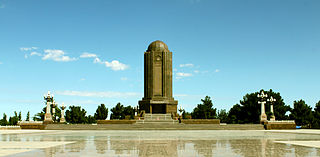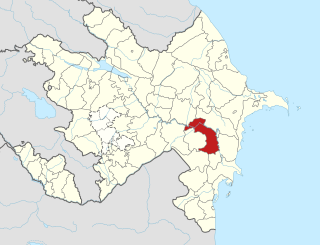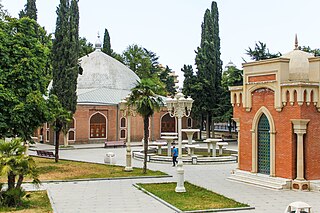
Ganja is Azerbaijan's third largest city, with a population of around 335,600. The city has been a historic and cultural center throughout most of its existence. It was the capital of the Ganja Khanate until 1804; after Qajar Iran ceded it to the Russian Empire following the Treaty of Gulistan in 1813, it became part of the administrative divisions of the Georgia Governorate, Georgia-Imeretia Governorate, Tiflis Governorate, and Elizavetpol Governorate. Following the dissolution of the Russian Empire and the Transcaucasian Democratic Federative Republic, it became a part of the Azerbaijan Democratic Republic, followed by Azerbaijan SSR, and, since 1991, the Republic of Azerbaijan.

The Nizami Mausoleum, built in honor of the 12th-century Persian poet Nizami Ganjavi, stands just outside the city of Ganja, Azerbaijan. The mausoleum was originally built in 1947 in place of an old collapsed mausoleum, and rebuilt in its present form in 1991.

Sabirabad District is one of the 66 districts of Azerbaijan. It is located in the centre of the country and belongs to the Mil-Mughan Economic Region. The district borders the districts of Saatly, Imishli, Kurdamir, Hajigabul, Salyan, Bilasuvar, and the city of Shirvan. Its capital and largest city is Sabirabad. As of 2020, the district had a population of 178,800.

The Ganja Khanate was a semi-independent Caucasian khanate that was established in Afsharid Iran and existed in the territory of what is modern-day Azerbaijan between 1747-1805.
Ibrahim Khalil khan Javanshir (1732–1806) was an Azerbaijani Turkic khan of the Karabakh Khanate from the Javanshir family, who succeeded his father Panah-Ali khan Javanshir as the ruler of the khanate.

The Garden of Babur is a historic park in Kabul, Afghanistan, where the tomb of the first Mughal emperor Babur is also located. The garden is thought to have been developed around 1528, when Babur gave orders for the construction of an "avenue garden" in Kabul, described in some detail in his memoirs, the Baburnama.
Javad Khan Qajar was a member Ziyadoghlu Qajar, a clan of the Qajar tribe, as well as the sixth and the last khan of the Ganja Khanate from 1786 to 1804 before it was lost to Russia.

Qalaqayın is a village and the most populous municipality, except for the capital Sabirabad, in the Sabirabad Rayon of Azerbaijan. It has a population of 7,658.
The fortress of the historic Javad Khanate and the center of the Mughan district.

Iranian Armenia (1502–1828) refers to the period of Eastern Armenia during the early-modern and late-modern era when it was part of the Iranian empire. Armenians have a history of being divided since the time of the Byzantine Empire and the Sassanid Empire, in the early 5th century. While the two sides of Armenia were sometimes reunited, this became a permanent aspect of the Armenian people.

Juma Mosque of Ganja or Friday Mosque of Ganja is a mosque located in the centre of Ganja, Azerbaijan. The mosque was built in 1606, according to a project of Sheykh Baheddin Mohammad Amili. The mosque is also often called “Shah Abbas Mosque” because it was built on the instructions of Shah Abbas the Great during his reign.

The Battle of Ganja, Siege of Ganja Fortress or Assault on Ganja, was the result of a Russian offensive in the South Caucasus intended to conquer the Ganja Khanate of Qajar Iran, which contributed to the escalation of the Russo-Persian War (1804–1813).

Imamzadeh Mausoleum or Goy Imam Mosque is located 7 km northward to Ganja. It consists of a complex including walls with entrances, small mosques and funerary monuments. The mausoleum, located inside the mosque, bears the grave of Imamzadeh Ibrahim, son of Imam Muhammad al-Baqir, the fifth Imam of Shi'a Muslims.

Chokak Hamam is a historical bath near Juma Mosque in Ganja.

Palace of Ganja Khans was the palace of Javad Khan, the last ruler of the Ganja khanate. The palace once located in the center of the city of Ganja, at west of Juma Mosque. The remaining ruins were demolished in 1974 and the Baku Cinema now occupies the palace site. Mausoleum of the last ruler of Ganja, Javad Khan was erected nearby.

Shamshadil was a sultanate in the South Caucasus established in 1747. It was located in what is now northeastern Armenia and northwestern Azerbaijan.
Ughurlu Khan or Oghurlu Khan was a claimant to Khanate of Ganja and a member Ziyadoghlu Qajar, a clan of the Qajar tribe.

Shah Abbas Square is a square located in the historical center of the city of Ganja, Azerbaijan. At one time, it was the main memorial complex of the suburb of the Ganja fortress. The complex of Shah Abbas Square was firstly mentioned in the plan of the Ganja fortress of 1797. This architectural ensemble, located in the center of the suburb, consisted of a mosque, a bathhouse and other buildings.

Shah Abbas Caravanserai was built in Ganja by order of Shah Abbas. The caravansary was connected to Chokak Hamam and Shah Abbas Mosque by underground roads.
















